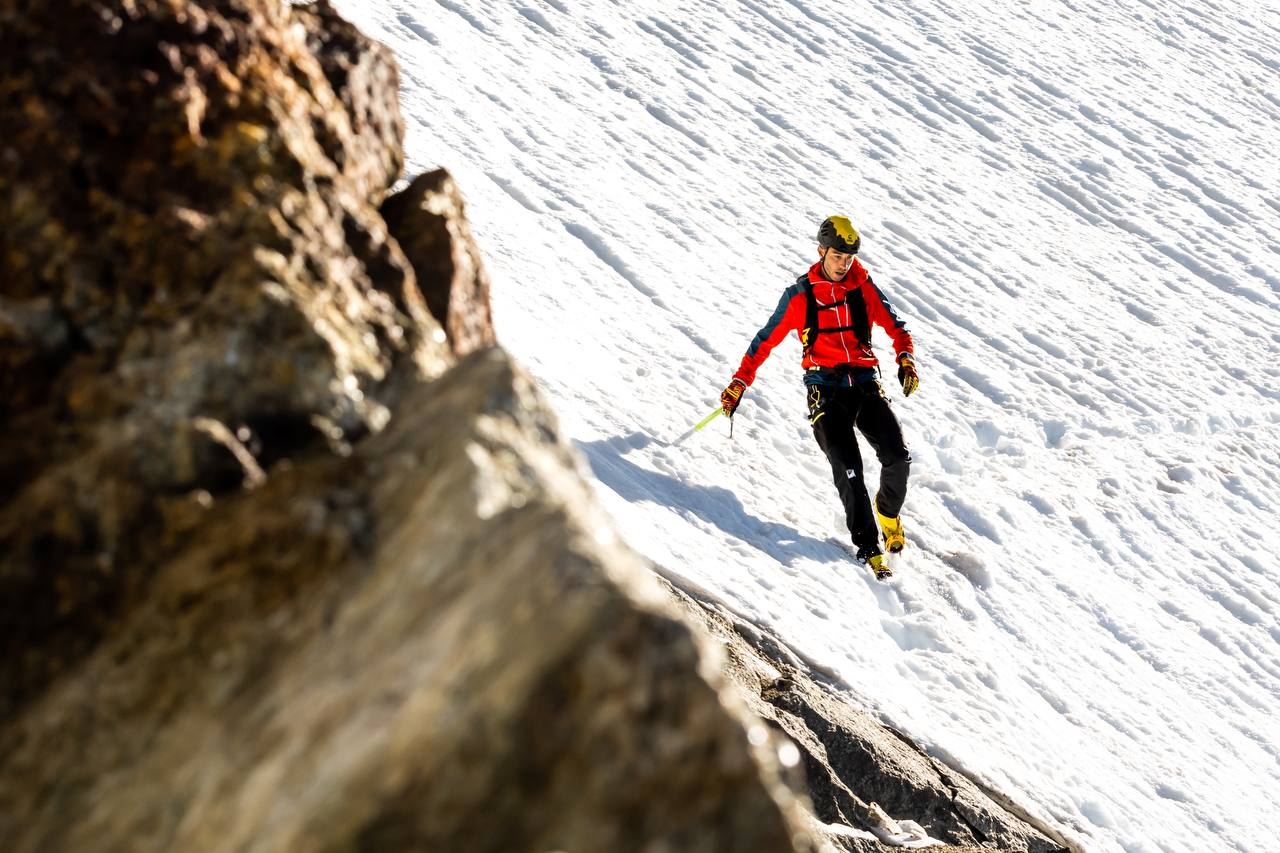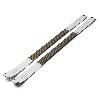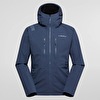Nadir Maguet sets new FKT on Grandes Jorasses, 3:19 round trip via the Normal Route

 1 / 6
1 / 6 Evi Garbolino
Evi Garbolino
On Monday 10 July, 29-year-old Nadir Maguet set a new, incredible speed record on the Grandes Jorasses in the Mont Blanc massif. Starting at 06.00 from Planpincieux (Courmayeur-Val Ferret), Maguet raced up the Normal route which leads to Pointe Walker (4208m), the highest point on this famous ridge.
Maguet started running up to the Boccalatte refuge and needed just just 40 minutes to ascend the approximately one thousand meters in altitude gain. Here he changed into mountaineering gear and continued tied in with his climbing partner Davide Cheraz who accompanied him for about 300 meters across the most crevassed section. Maguet then continued solo again, up the Whymper gully to the summit of Pointe Walker where, after 2 hours and 17 minutes, he was welcomed by mountain guide Marco Camandona before starting the descent. 3 hours and 19 minutes after setting off he returned to Planpincieux, setting a new Fastest Known Time (FKT) for this route. The previous "record" dates back to 1993, when Alfredo Mammoliti stopped the clock after 4:03:26. Here are the details directly from Maguet.
Congratulations Nader! Where did this idea come from?
The idea of the record on the Grandes Jorasses came about 6 years ago and I clearly remember asking the mountain guide and former ski mountaineering athlete Denis Trento to take me up the Via Normale to see what it was like. After a few days he called me saying "let's go, but let's take another route and descend down the normal one." I was thrilled with the idea but having never gone into the high mountains to do some mountaineering routes, I didn't know what I was letting myself in to. That route he chose was the traverse of the Grandes Jorasses... I remember that it was a really tough day for me and I confess that I had partially pissed my pants... We finished the route in one day from Punta Helbronner in Val Ferret, and maybe it's because of that day that I put this project off for so long. Looking back, maybe this was a good thing, because I wasn't mature enough as an athlete to face this challenge!
Can you tell us something the route?
The route I took starts from Planpencieux in Val Ferret, it's a round trip to the highest peak of the Grandes Jorasses, Pointe Walker via the normal route. I made a couple of detours (which Alfredo Mammoliti took in 1993 when he set the record): one is a gully next to the Boccalatte hut, and the other is to skip the Reposoir staying on the glacier to the right. The entire up & down is a vertical gain of about 2600 D+ and 14km.
How well did you know the route?
I've actually done it twice. The first 6 years ago when Denis and I descended after the West Face, and the other time 3 days before the record. I went with my friend Hervé Vevey on a reconnaissance tour to see what the conditions were like on the glacier. The incredible thing is that, with this heat, in those three days the changes were blindingly obvious! A snow bridge that was on Friday was already collapsed on the day of the record!
You left at 6 am. Why this time?
I set off at 6 in the morning so there was enough light and, considering it would take less than 4 hours, I wouldn't have any problems on the crevassed section which stays in the shade for a long time in the morning.
What tactics did you use?
I set off in running gear for the first 1000 meters up to the Boaccalatte refuge, and then changed into a mountaineering gear with boots, crampons and ice axe where the snow and glaciers begin. For the most crevassed section (about 300 metres) at the base of the Reposoir I short-roped with Davide Cheraz, who was there waiting for me, both on the ascent and descent. All the rest I did alone. This decision to rope up with him was only to minimize the risks.
Talking of which: how much did you risk? How much margin for error was there?
I don't think I ever risked much during the entire ascent and descent, and on the steepest and most dangerous sections I went more slowly in order to concentrate even more on what I was doing. Obviously there are objective hazards that don't depend on me, such as falling rocks, serac collapse and snow bridges giving way above crevasses, but in these cases a fast&light approach can be synonymous with safety, because the less time you spend, for example, in a gully, the less hazards you're exposed to.
Makes sense. Then you continued to the top. How did you feel up there?
When I reached the summit I felt good and was overwhelmed with emotions. I managed to disconnect my brain for a few moments and just enjoy that moment. Marco Camandona was there, we hugged briefly then I concentrated again on the descent.
Marco waited for you on the summit?
Yes, Marco was waiting for me 100 meters below the top. I made fun of him because I beat him to the top, he who is the man of the 8000ers! I have an excellent relationship with him and if I've become the athlete that I am today, it's largely thanks to him. Being able to hug him at the top was a great, beautiful and emotional moment.
What about conditions?
Conditions for setting the record they were perfect. At the bottom the snow had frozen hard but not completely, so I was very fast when going downhill, higher up the glacier was frozen solid, and the trail was also excellent all the way up to the summit.
Then you descended at great speed...
I needed 1:02 for the descent, but here too I didn't take any risks. On the easier sections I ran and went fast, on the more delicate sections such as the rocks under the serac and the Whymper gully I took my time to watch where I put my feet and not risk slipping. But as I said, conditions were excellent.
What do you think of the time you set?
In my opinion it's a great time, I'm currently enjoying a moment of great form where I can push hard uphill. It's also worth considering that 30 years have passed since the old record, when conditions of the glacier certainly weren't the same as they are today. I think everything went according to plan, everything was perfect, perhaps the time can be improved on a bit, but only by taking unnecessary risks.
And what about Mammoliti's time 30 years ago?
Personally I don't know Alfredo, I know that he was a pioneer of these records and of skyrunning, a good athlete of Bruno Brunod's era. His time 30 years ago had always intrigued me, and being able to improve on it now is a dream come true.



 Copia link
Copia link





 See all photos
See all photos
























